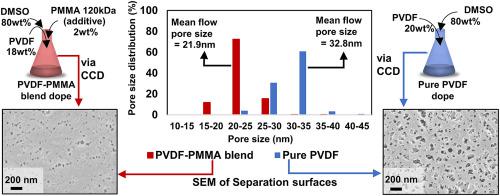当前位置:
X-MOL 学术
›
J. Membr. Sci.
›
论文详情
Our official English website, www.x-mol.net, welcomes your
feedback! (Note: you will need to create a separate account there.)
Blending modification to porous polyvinylidene fluoride (PVDF) membranes prepared via combined crystallisation and diffusion (CCD) technique
Journal of Membrane Science ( IF 8.4 ) Pub Date : 2021-01-01 , DOI: 10.1016/j.memsci.2020.118708 Vatsal Shah , Bo Wang , Kang Li
Journal of Membrane Science ( IF 8.4 ) Pub Date : 2021-01-01 , DOI: 10.1016/j.memsci.2020.118708 Vatsal Shah , Bo Wang , Kang Li

|
Abstract PVDF membranes prepared by the combined crystallisation and diffusion (CCD) technique, a variation of ice templating, have shown permeation rates far superior to those made via conventional methods such as nonsolvent induced phase separation (NIPS) or thermally induced phase separation (TIPS). However, so far the smallest pore size achieved for PVDF membranes prepared by CCD is about 30 nm. In this study, the pore size of CCD PVDF membranes is reduced to 15 nm by blending poly(methyl methacrylate) (PMMA) into PVDF-dimethyl sulfoxide (DMSO) dope solutions without altering the operational conditions. Systemic study shows the pore size reduces when increasing PMMA concentration in the membranes; but after an initial drop compared to the pure PVDF membrane, the pure water flux doesn't decline with PMMA concentration. The effect of different molecular weights of PMMA (120 kDa and 35 kDa) was also investigated, where the results showed a smaller pore size for membranes prepared using the higher molecular weight PMMA. Scanning electron microscopy (SEM), cloud-point temperature measurement and Fourier transform infrared spectroscopy (FTIR) was used to characterise the membranes and help understand how PMMA affects membrane formation. From the evidence gathered, we attribute the effects of PMMA to the change in the number of nucleation centres, diffusional rates, as well as the gelation point based on a previously proposed CCD mechanism.
中文翻译:

对通过组合结晶和扩散 (CCD) 技术制备的多孔聚偏二氟乙烯 (PVDF) 膜进行共混改性
摘要 采用结晶和扩散相结合 (CCD) 技术制备的 PVDF 膜是冰模板的一种变体,其渗透率远远优于通过非溶剂诱导相分离 (NIPS) 或热诱导相分离 (TIPS) 等常规方法制备的膜。 . 然而,迄今为止,由 CCD 制备的 PVDF 膜实现的最小孔径约为 30 nm。在这项研究中,通过将聚甲基丙烯酸甲酯 (PMMA) 混合到 PVDF-二甲基亚砜 (DMSO) 掺杂溶液中,在不改变操作条件的情况下,CCD PVDF 膜的孔径减小到 15 nm。系统研究表明,随着膜中 PMMA 浓度的增加,孔径减小;但与纯 PVDF 膜相比,在初始下降后,纯水通量不会随 PMMA 浓度而下降。还研究了不同分子量的 PMMA(120 kDa 和 35 kDa)的影响,结果显示使用较高分子量 PMMA 制备的膜孔径较小。扫描电子显微镜 (SEM)、浊点温度测量和傅里叶变换红外光谱 (FTIR) 用于表征膜并帮助了解 PMMA 如何影响膜形成。根据收集的证据,我们将 PMMA 的影响归因于成核中心数量、扩散速率以及基于先前提出的 CCD 机制的凝胶点的变化。浊点温度测量和傅里叶变换红外光谱 (FTIR) 用于表征膜并帮助了解 PMMA 如何影响膜形成。根据收集的证据,我们将 PMMA 的影响归因于成核中心数量、扩散速率以及基于先前提出的 CCD 机制的凝胶点的变化。浊点温度测量和傅里叶变换红外光谱 (FTIR) 用于表征膜并帮助了解 PMMA 如何影响膜形成。根据收集的证据,我们将 PMMA 的影响归因于成核中心数量、扩散速率以及基于先前提出的 CCD 机制的凝胶点的变化。
更新日期:2021-01-01
中文翻译:

对通过组合结晶和扩散 (CCD) 技术制备的多孔聚偏二氟乙烯 (PVDF) 膜进行共混改性
摘要 采用结晶和扩散相结合 (CCD) 技术制备的 PVDF 膜是冰模板的一种变体,其渗透率远远优于通过非溶剂诱导相分离 (NIPS) 或热诱导相分离 (TIPS) 等常规方法制备的膜。 . 然而,迄今为止,由 CCD 制备的 PVDF 膜实现的最小孔径约为 30 nm。在这项研究中,通过将聚甲基丙烯酸甲酯 (PMMA) 混合到 PVDF-二甲基亚砜 (DMSO) 掺杂溶液中,在不改变操作条件的情况下,CCD PVDF 膜的孔径减小到 15 nm。系统研究表明,随着膜中 PMMA 浓度的增加,孔径减小;但与纯 PVDF 膜相比,在初始下降后,纯水通量不会随 PMMA 浓度而下降。还研究了不同分子量的 PMMA(120 kDa 和 35 kDa)的影响,结果显示使用较高分子量 PMMA 制备的膜孔径较小。扫描电子显微镜 (SEM)、浊点温度测量和傅里叶变换红外光谱 (FTIR) 用于表征膜并帮助了解 PMMA 如何影响膜形成。根据收集的证据,我们将 PMMA 的影响归因于成核中心数量、扩散速率以及基于先前提出的 CCD 机制的凝胶点的变化。浊点温度测量和傅里叶变换红外光谱 (FTIR) 用于表征膜并帮助了解 PMMA 如何影响膜形成。根据收集的证据,我们将 PMMA 的影响归因于成核中心数量、扩散速率以及基于先前提出的 CCD 机制的凝胶点的变化。浊点温度测量和傅里叶变换红外光谱 (FTIR) 用于表征膜并帮助了解 PMMA 如何影响膜形成。根据收集的证据,我们将 PMMA 的影响归因于成核中心数量、扩散速率以及基于先前提出的 CCD 机制的凝胶点的变化。











































 京公网安备 11010802027423号
京公网安备 11010802027423号